ICT Strategy and Management: Innovation in Business Enterprises Report
VerifiedAdded on 2022/09/22
|22
|4462
|27
Report
AI Summary
This report, titled "ICT Strategy and Management: IT Strategies for Product and Service Innovation in Business Enterprises," explores the crucial integration of business strategy and information systems technology. It highlights how IT, particularly information systems, has revolutionized businesses by optimizing customer service, supply chain operations, knowledge management, and decision-making. The report delves into the impact of IT on product and service innovation, emphasizing its role in achieving competitive advantage. It examines key systems like Customer Relationship Management (CRM), Enterprise Resource Planning (ERP), Supply Chain Management (SCM), Knowledge Management (KM), and Business Intelligence (BI) systems. The report stresses the importance of aligning IT strategies with business objectives to leverage IT resources effectively in today's dynamic economic environment. It provides insights into how businesses can gain and sustain a competitive edge by adopting and utilizing these information systems. The report also addresses the relationship between business strategy and information systems and how they influence each other to create value and achieve business objectives. It underscores the need for flexible corporations with resilient IT infrastructure to adapt to the ever-changing market conditions. The report also details the benefits and importance of CRM and ERP systems, including how they enhance customer service, facilitate the discovery of prospective customers, increase customer revenues, improve operational cross and up-selling of products, and save money while improving productivity.

ICT Strategy and Management 1
ICT STRATEGY AND MANAGEMENT
by [Name]
Professor’s Name
Course Title
Course Code
City/State
Date
ICT STRATEGY AND MANAGEMENT
by [Name]
Professor’s Name
Course Title
Course Code
City/State
Date
Paraphrase This Document
Need a fresh take? Get an instant paraphrase of this document with our AI Paraphraser
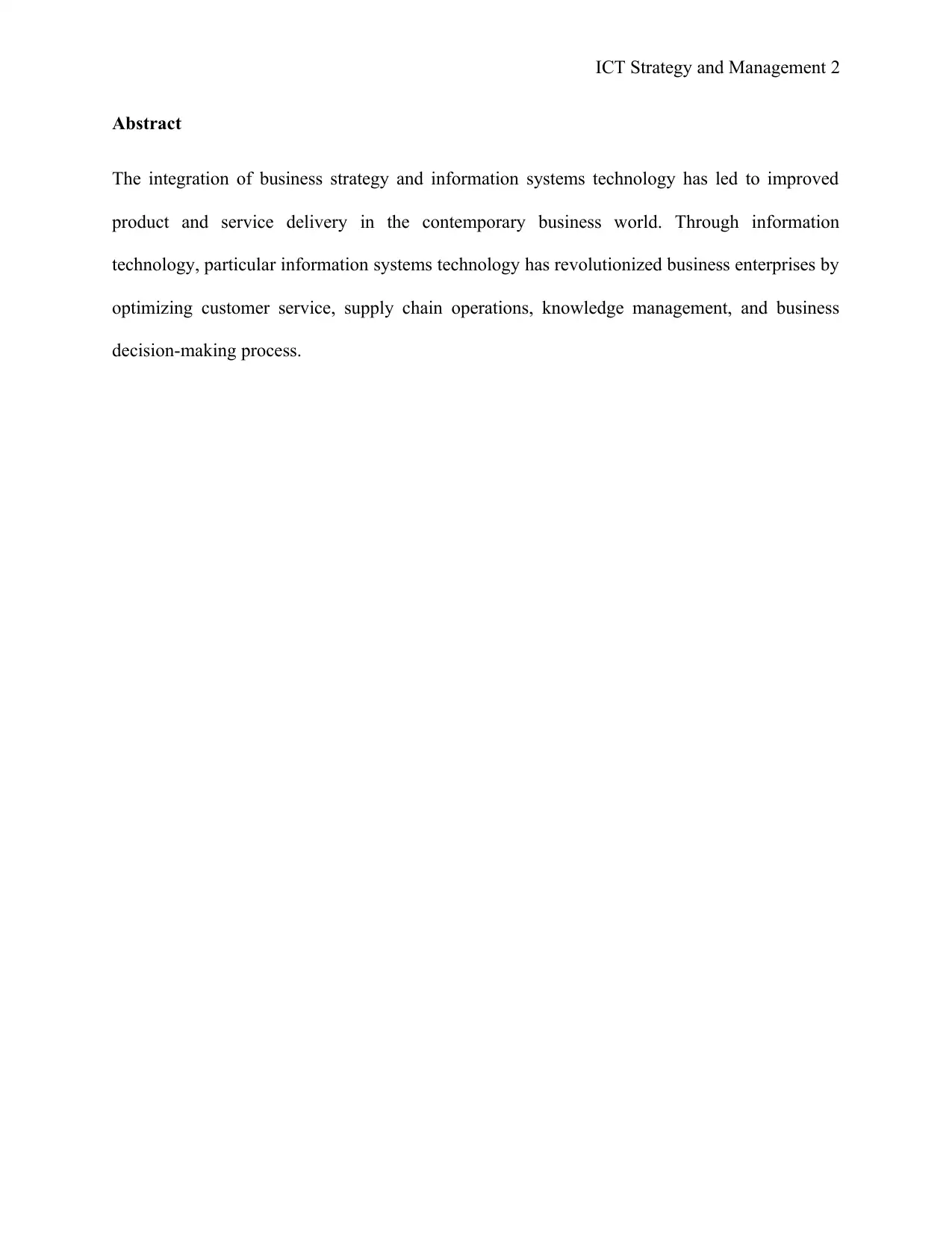
ICT Strategy and Management 2
Abstract
The integration of business strategy and information systems technology has led to improved
product and service delivery in the contemporary business world. Through information
technology, particular information systems technology has revolutionized business enterprises by
optimizing customer service, supply chain operations, knowledge management, and business
decision-making process.
Abstract
The integration of business strategy and information systems technology has led to improved
product and service delivery in the contemporary business world. Through information
technology, particular information systems technology has revolutionized business enterprises by
optimizing customer service, supply chain operations, knowledge management, and business
decision-making process.
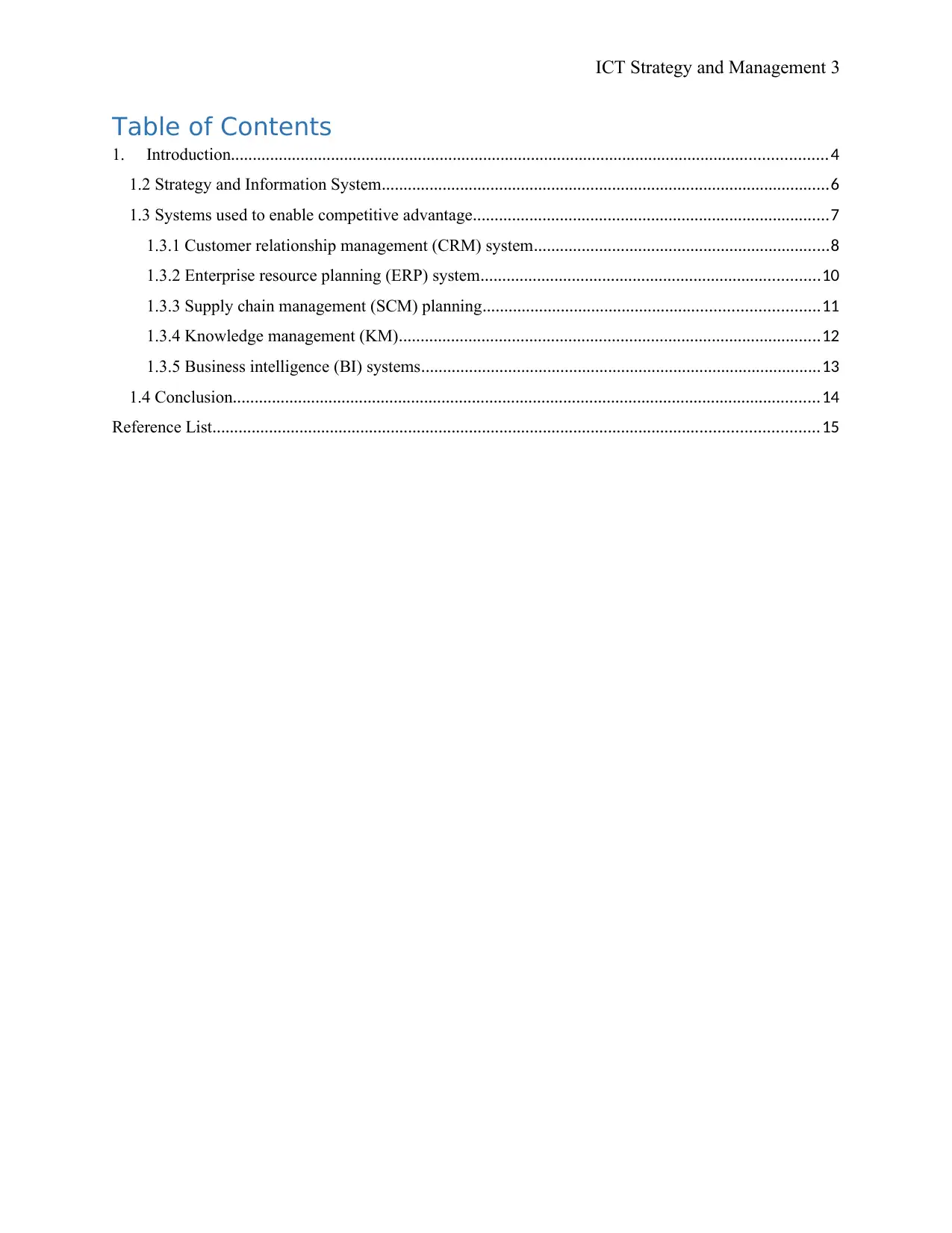
ICT Strategy and Management 3
Table of Contents
1. Introduction.........................................................................................................................................4
1.2 Strategy and Information System.......................................................................................................6
1.3 Systems used to enable competitive advantage..................................................................................7
1.3.1 Customer relationship management (CRM) system....................................................................8
1.3.2 Enterprise resource planning (ERP) system..............................................................................10
1.3.3 Supply chain management (SCM) planning.............................................................................11
1.3.4 Knowledge management (KM).................................................................................................12
1.3.5 Business intelligence (BI) systems............................................................................................13
1.4 Conclusion.......................................................................................................................................14
Reference List...........................................................................................................................................15
Table of Contents
1. Introduction.........................................................................................................................................4
1.2 Strategy and Information System.......................................................................................................6
1.3 Systems used to enable competitive advantage..................................................................................7
1.3.1 Customer relationship management (CRM) system....................................................................8
1.3.2 Enterprise resource planning (ERP) system..............................................................................10
1.3.3 Supply chain management (SCM) planning.............................................................................11
1.3.4 Knowledge management (KM).................................................................................................12
1.3.5 Business intelligence (BI) systems............................................................................................13
1.4 Conclusion.......................................................................................................................................14
Reference List...........................................................................................................................................15
⊘ This is a preview!⊘
Do you want full access?
Subscribe today to unlock all pages.

Trusted by 1+ million students worldwide
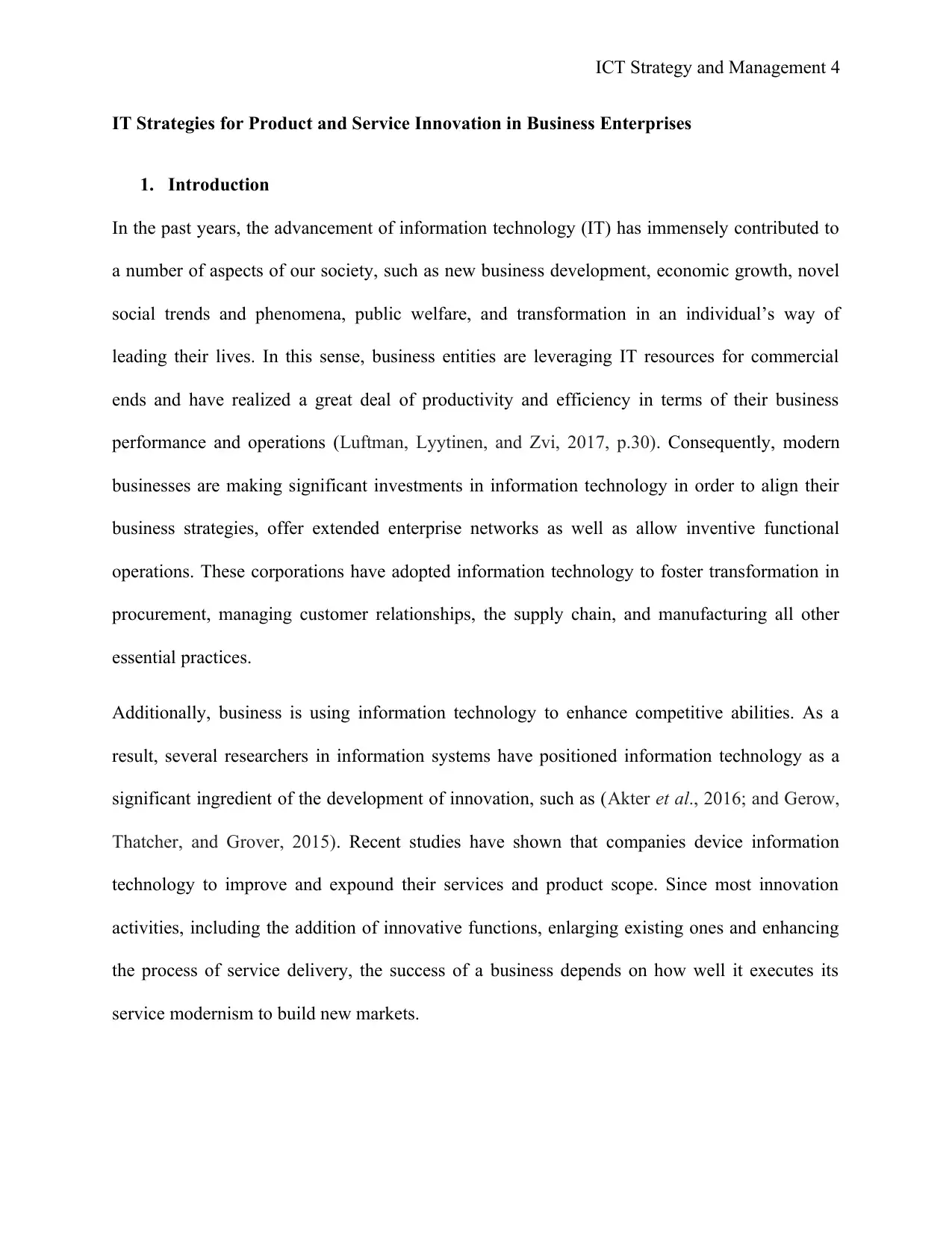
ICT Strategy and Management 4
IT Strategies for Product and Service Innovation in Business Enterprises
1. Introduction
In the past years, the advancement of information technology (IT) has immensely contributed to
a number of aspects of our society, such as new business development, economic growth, novel
social trends and phenomena, public welfare, and transformation in an individual’s way of
leading their lives. In this sense, business entities are leveraging IT resources for commercial
ends and have realized a great deal of productivity and efficiency in terms of their business
performance and operations (Luftman, Lyytinen, and Zvi, 2017, p.30). Consequently, modern
businesses are making significant investments in information technology in order to align their
business strategies, offer extended enterprise networks as well as allow inventive functional
operations. These corporations have adopted information technology to foster transformation in
procurement, managing customer relationships, the supply chain, and manufacturing all other
essential practices.
Additionally, business is using information technology to enhance competitive abilities. As a
result, several researchers in information systems have positioned information technology as a
significant ingredient of the development of innovation, such as (Akter et al., 2016; and Gerow,
Thatcher, and Grover, 2015). Recent studies have shown that companies device information
technology to improve and expound their services and product scope. Since most innovation
activities, including the addition of innovative functions, enlarging existing ones and enhancing
the process of service delivery, the success of a business depends on how well it executes its
service modernism to build new markets.
IT Strategies for Product and Service Innovation in Business Enterprises
1. Introduction
In the past years, the advancement of information technology (IT) has immensely contributed to
a number of aspects of our society, such as new business development, economic growth, novel
social trends and phenomena, public welfare, and transformation in an individual’s way of
leading their lives. In this sense, business entities are leveraging IT resources for commercial
ends and have realized a great deal of productivity and efficiency in terms of their business
performance and operations (Luftman, Lyytinen, and Zvi, 2017, p.30). Consequently, modern
businesses are making significant investments in information technology in order to align their
business strategies, offer extended enterprise networks as well as allow inventive functional
operations. These corporations have adopted information technology to foster transformation in
procurement, managing customer relationships, the supply chain, and manufacturing all other
essential practices.
Additionally, business is using information technology to enhance competitive abilities. As a
result, several researchers in information systems have positioned information technology as a
significant ingredient of the development of innovation, such as (Akter et al., 2016; and Gerow,
Thatcher, and Grover, 2015). Recent studies have shown that companies device information
technology to improve and expound their services and product scope. Since most innovation
activities, including the addition of innovative functions, enlarging existing ones and enhancing
the process of service delivery, the success of a business depends on how well it executes its
service modernism to build new markets.
Paraphrase This Document
Need a fresh take? Get an instant paraphrase of this document with our AI Paraphraser
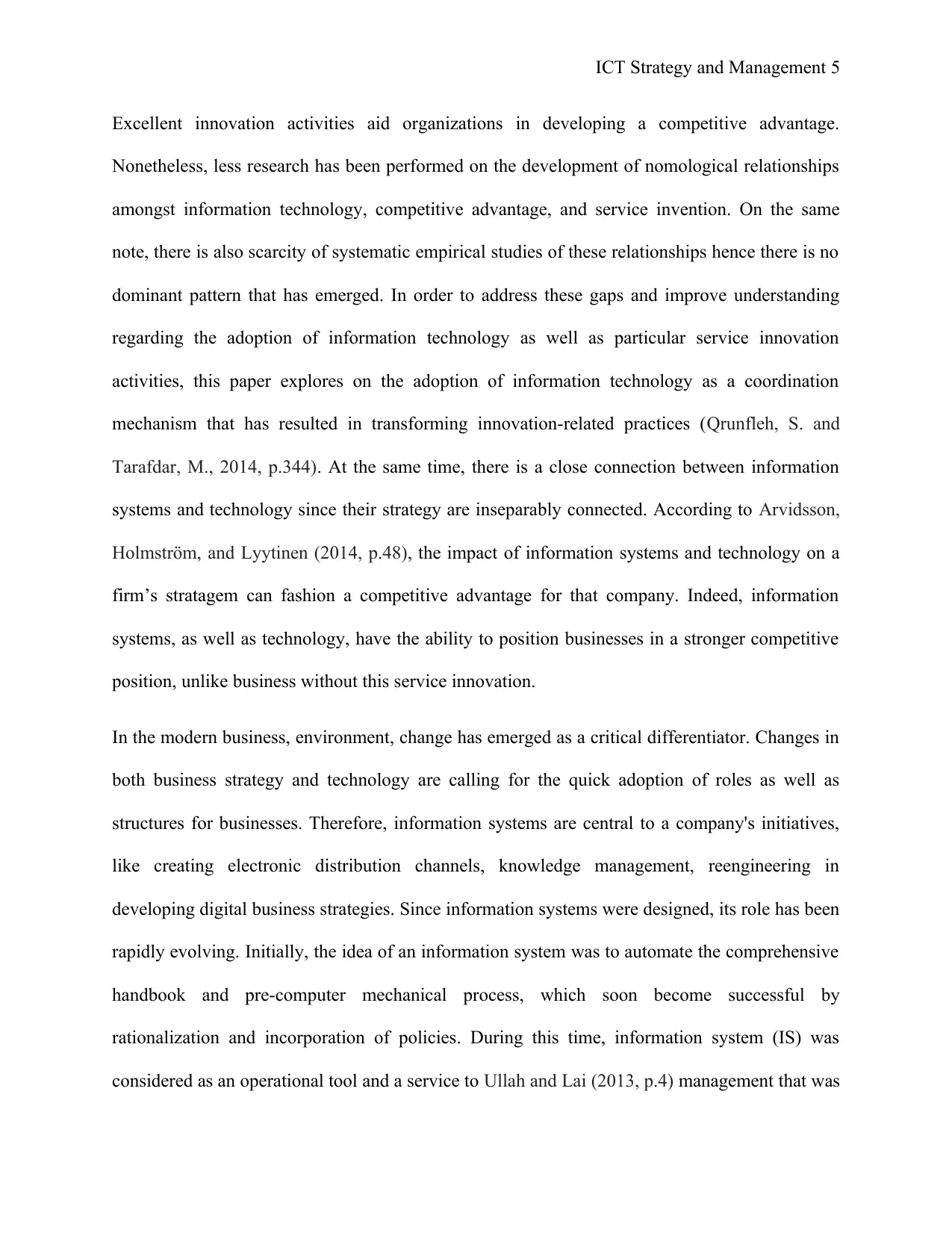
ICT Strategy and Management 5
Excellent innovation activities aid organizations in developing a competitive advantage.
Nonetheless, less research has been performed on the development of nomological relationships
amongst information technology, competitive advantage, and service invention. On the same
note, there is also scarcity of systematic empirical studies of these relationships hence there is no
dominant pattern that has emerged. In order to address these gaps and improve understanding
regarding the adoption of information technology as well as particular service innovation
activities, this paper explores on the adoption of information technology as a coordination
mechanism that has resulted in transforming innovation-related practices (Qrunfleh, S. and
Tarafdar, M., 2014, p.344). At the same time, there is a close connection between information
systems and technology since their strategy are inseparably connected. According to Arvidsson,
Holmström, and Lyytinen (2014, p.48), the impact of information systems and technology on a
firm’s stratagem can fashion a competitive advantage for that company. Indeed, information
systems, as well as technology, have the ability to position businesses in a stronger competitive
position, unlike business without this service innovation.
In the modern business, environment, change has emerged as a critical differentiator. Changes in
both business strategy and technology are calling for the quick adoption of roles as well as
structures for businesses. Therefore, information systems are central to a company's initiatives,
like creating electronic distribution channels, knowledge management, reengineering in
developing digital business strategies. Since information systems were designed, its role has been
rapidly evolving. Initially, the idea of an information system was to automate the comprehensive
handbook and pre-computer mechanical process, which soon become successful by
rationalization and incorporation of policies. During this time, information system (IS) was
considered as an operational tool and a service to Ullah and Lai (2013, p.4) management that was
Excellent innovation activities aid organizations in developing a competitive advantage.
Nonetheless, less research has been performed on the development of nomological relationships
amongst information technology, competitive advantage, and service invention. On the same
note, there is also scarcity of systematic empirical studies of these relationships hence there is no
dominant pattern that has emerged. In order to address these gaps and improve understanding
regarding the adoption of information technology as well as particular service innovation
activities, this paper explores on the adoption of information technology as a coordination
mechanism that has resulted in transforming innovation-related practices (Qrunfleh, S. and
Tarafdar, M., 2014, p.344). At the same time, there is a close connection between information
systems and technology since their strategy are inseparably connected. According to Arvidsson,
Holmström, and Lyytinen (2014, p.48), the impact of information systems and technology on a
firm’s stratagem can fashion a competitive advantage for that company. Indeed, information
systems, as well as technology, have the ability to position businesses in a stronger competitive
position, unlike business without this service innovation.
In the modern business, environment, change has emerged as a critical differentiator. Changes in
both business strategy and technology are calling for the quick adoption of roles as well as
structures for businesses. Therefore, information systems are central to a company's initiatives,
like creating electronic distribution channels, knowledge management, reengineering in
developing digital business strategies. Since information systems were designed, its role has been
rapidly evolving. Initially, the idea of an information system was to automate the comprehensive
handbook and pre-computer mechanical process, which soon become successful by
rationalization and incorporation of policies. During this time, information system (IS) was
considered as an operational tool and a service to Ullah and Lai (2013, p.4) management that was
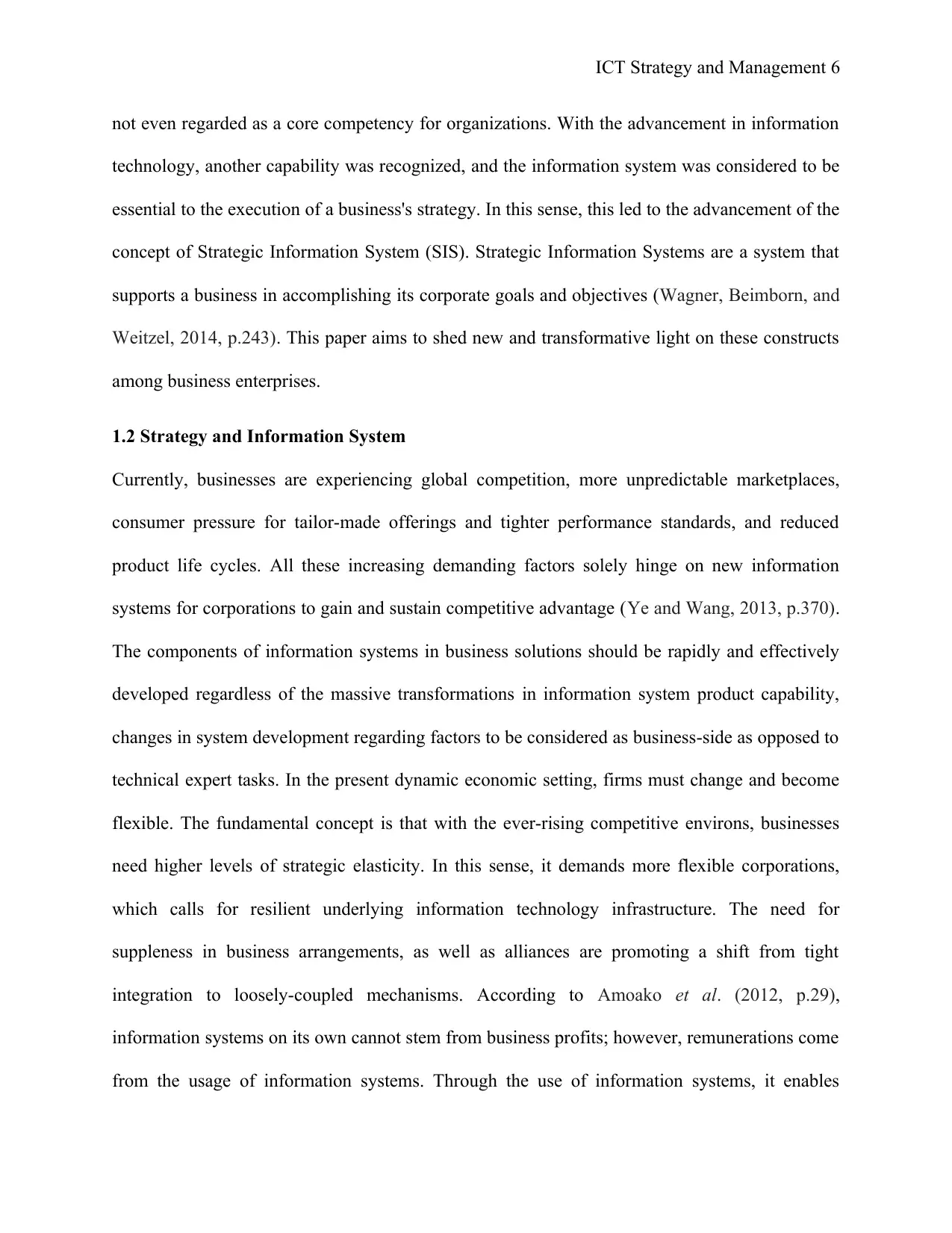
ICT Strategy and Management 6
not even regarded as a core competency for organizations. With the advancement in information
technology, another capability was recognized, and the information system was considered to be
essential to the execution of a business's strategy. In this sense, this led to the advancement of the
concept of Strategic Information System (SIS). Strategic Information Systems are a system that
supports a business in accomplishing its corporate goals and objectives (Wagner, Beimborn, and
Weitzel, 2014, p.243). This paper aims to shed new and transformative light on these constructs
among business enterprises.
1.2 Strategy and Information System
Currently, businesses are experiencing global competition, more unpredictable marketplaces,
consumer pressure for tailor-made offerings and tighter performance standards, and reduced
product life cycles. All these increasing demanding factors solely hinge on new information
systems for corporations to gain and sustain competitive advantage (Ye and Wang, 2013, p.370).
The components of information systems in business solutions should be rapidly and effectively
developed regardless of the massive transformations in information system product capability,
changes in system development regarding factors to be considered as business-side as opposed to
technical expert tasks. In the present dynamic economic setting, firms must change and become
flexible. The fundamental concept is that with the ever-rising competitive environs, businesses
need higher levels of strategic elasticity. In this sense, it demands more flexible corporations,
which calls for resilient underlying information technology infrastructure. The need for
suppleness in business arrangements, as well as alliances are promoting a shift from tight
integration to loosely-coupled mechanisms. According to Amoako et al. (2012, p.29),
information systems on its own cannot stem from business profits; however, remunerations come
from the usage of information systems. Through the use of information systems, it enables
not even regarded as a core competency for organizations. With the advancement in information
technology, another capability was recognized, and the information system was considered to be
essential to the execution of a business's strategy. In this sense, this led to the advancement of the
concept of Strategic Information System (SIS). Strategic Information Systems are a system that
supports a business in accomplishing its corporate goals and objectives (Wagner, Beimborn, and
Weitzel, 2014, p.243). This paper aims to shed new and transformative light on these constructs
among business enterprises.
1.2 Strategy and Information System
Currently, businesses are experiencing global competition, more unpredictable marketplaces,
consumer pressure for tailor-made offerings and tighter performance standards, and reduced
product life cycles. All these increasing demanding factors solely hinge on new information
systems for corporations to gain and sustain competitive advantage (Ye and Wang, 2013, p.370).
The components of information systems in business solutions should be rapidly and effectively
developed regardless of the massive transformations in information system product capability,
changes in system development regarding factors to be considered as business-side as opposed to
technical expert tasks. In the present dynamic economic setting, firms must change and become
flexible. The fundamental concept is that with the ever-rising competitive environs, businesses
need higher levels of strategic elasticity. In this sense, it demands more flexible corporations,
which calls for resilient underlying information technology infrastructure. The need for
suppleness in business arrangements, as well as alliances are promoting a shift from tight
integration to loosely-coupled mechanisms. According to Amoako et al. (2012, p.29),
information systems on its own cannot stem from business profits; however, remunerations come
from the usage of information systems. Through the use of information systems, it enables
⊘ This is a preview!⊘
Do you want full access?
Subscribe today to unlock all pages.

Trusted by 1+ million students worldwide
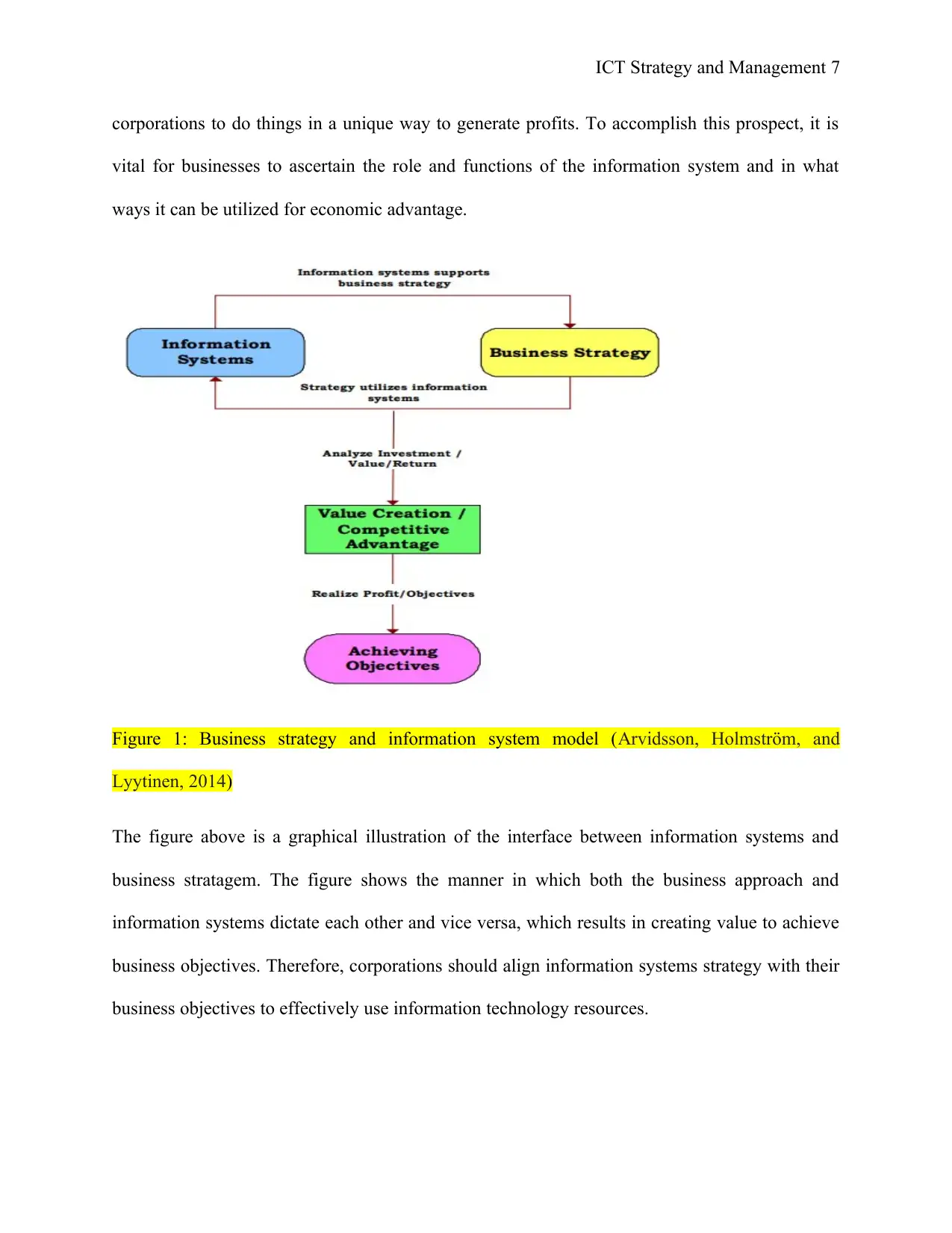
ICT Strategy and Management 7
corporations to do things in a unique way to generate profits. To accomplish this prospect, it is
vital for businesses to ascertain the role and functions of the information system and in what
ways it can be utilized for economic advantage.
Figure 1: Business strategy and information system model (Arvidsson, Holmström, and
Lyytinen, 2014)
The figure above is a graphical illustration of the interface between information systems and
business stratagem. The figure shows the manner in which both the business approach and
information systems dictate each other and vice versa, which results in creating value to achieve
business objectives. Therefore, corporations should align information systems strategy with their
business objectives to effectively use information technology resources.
corporations to do things in a unique way to generate profits. To accomplish this prospect, it is
vital for businesses to ascertain the role and functions of the information system and in what
ways it can be utilized for economic advantage.
Figure 1: Business strategy and information system model (Arvidsson, Holmström, and
Lyytinen, 2014)
The figure above is a graphical illustration of the interface between information systems and
business stratagem. The figure shows the manner in which both the business approach and
information systems dictate each other and vice versa, which results in creating value to achieve
business objectives. Therefore, corporations should align information systems strategy with their
business objectives to effectively use information technology resources.
Paraphrase This Document
Need a fresh take? Get an instant paraphrase of this document with our AI Paraphraser
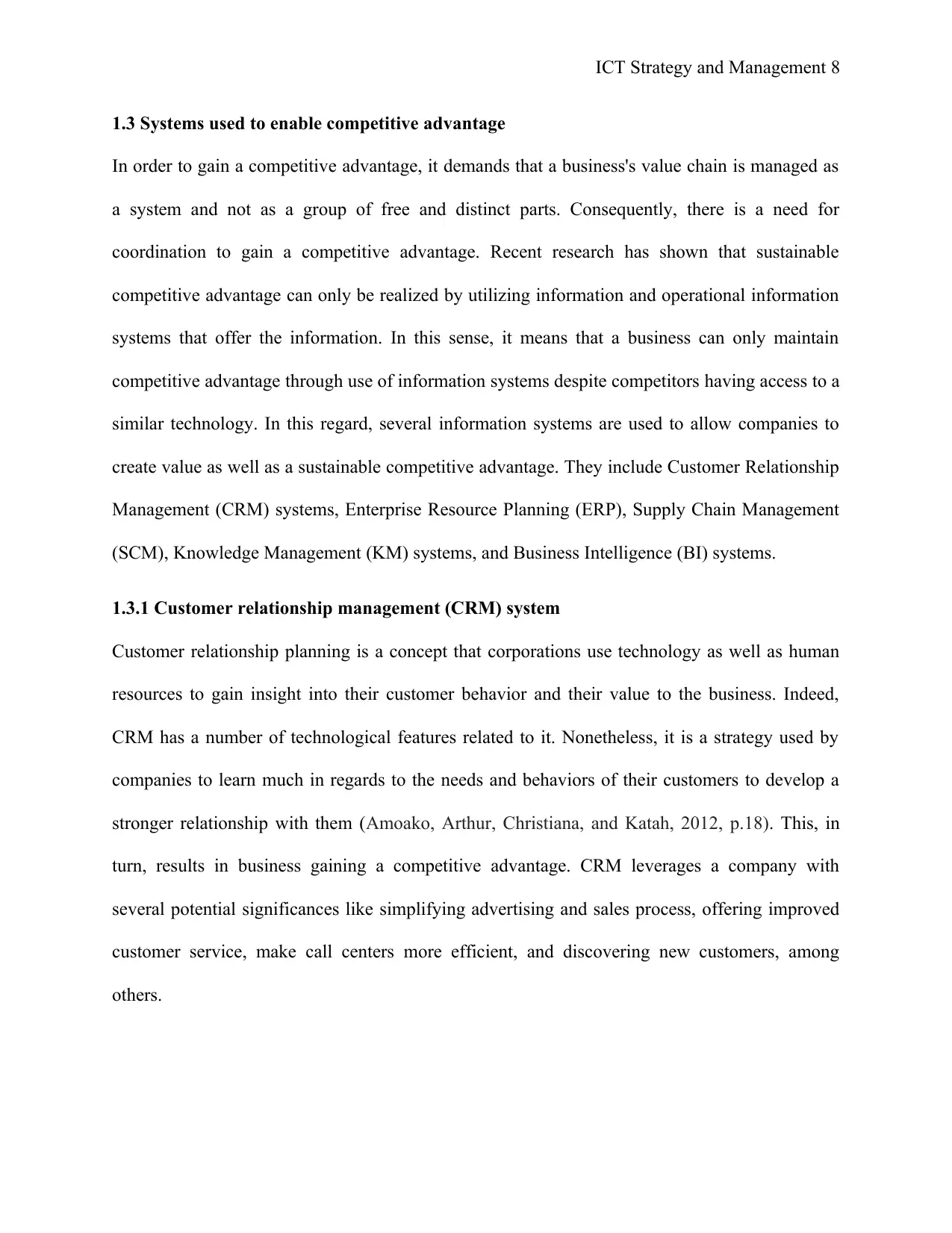
ICT Strategy and Management 8
1.3 Systems used to enable competitive advantage
In order to gain a competitive advantage, it demands that a business's value chain is managed as
a system and not as a group of free and distinct parts. Consequently, there is a need for
coordination to gain a competitive advantage. Recent research has shown that sustainable
competitive advantage can only be realized by utilizing information and operational information
systems that offer the information. In this sense, it means that a business can only maintain
competitive advantage through use of information systems despite competitors having access to a
similar technology. In this regard, several information systems are used to allow companies to
create value as well as a sustainable competitive advantage. They include Customer Relationship
Management (CRM) systems, Enterprise Resource Planning (ERP), Supply Chain Management
(SCM), Knowledge Management (KM) systems, and Business Intelligence (BI) systems.
1.3.1 Customer relationship management (CRM) system
Customer relationship planning is a concept that corporations use technology as well as human
resources to gain insight into their customer behavior and their value to the business. Indeed,
CRM has a number of technological features related to it. Nonetheless, it is a strategy used by
companies to learn much in regards to the needs and behaviors of their customers to develop a
stronger relationship with them (Amoako, Arthur, Christiana, and Katah, 2012, p.18). This, in
turn, results in business gaining a competitive advantage. CRM leverages a company with
several potential significances like simplifying advertising and sales process, offering improved
customer service, make call centers more efficient, and discovering new customers, among
others.
1.3 Systems used to enable competitive advantage
In order to gain a competitive advantage, it demands that a business's value chain is managed as
a system and not as a group of free and distinct parts. Consequently, there is a need for
coordination to gain a competitive advantage. Recent research has shown that sustainable
competitive advantage can only be realized by utilizing information and operational information
systems that offer the information. In this sense, it means that a business can only maintain
competitive advantage through use of information systems despite competitors having access to a
similar technology. In this regard, several information systems are used to allow companies to
create value as well as a sustainable competitive advantage. They include Customer Relationship
Management (CRM) systems, Enterprise Resource Planning (ERP), Supply Chain Management
(SCM), Knowledge Management (KM) systems, and Business Intelligence (BI) systems.
1.3.1 Customer relationship management (CRM) system
Customer relationship planning is a concept that corporations use technology as well as human
resources to gain insight into their customer behavior and their value to the business. Indeed,
CRM has a number of technological features related to it. Nonetheless, it is a strategy used by
companies to learn much in regards to the needs and behaviors of their customers to develop a
stronger relationship with them (Amoako, Arthur, Christiana, and Katah, 2012, p.18). This, in
turn, results in business gaining a competitive advantage. CRM leverages a company with
several potential significances like simplifying advertising and sales process, offering improved
customer service, make call centers more efficient, and discovering new customers, among
others.
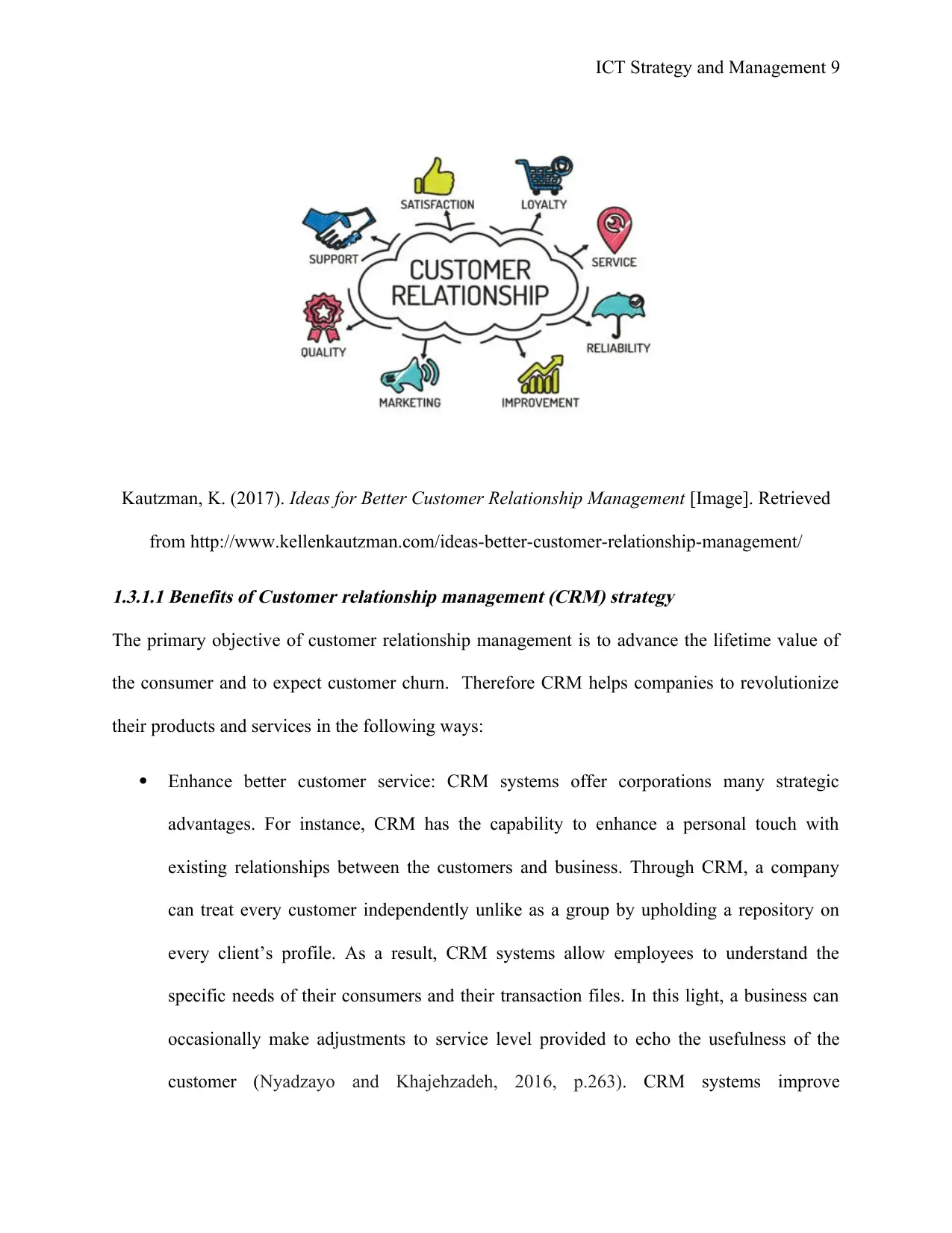
ICT Strategy and Management 9
Kautzman, K. (2017). Ideas for Better Customer Relationship Management [Image]. Retrieved
from http://www.kellenkautzman.com/ideas-better-customer-relationship-management/
1.3.1.1 Benefits of Customer relationship management (CRM) strategy
The primary objective of customer relationship management is to advance the lifetime value of
the consumer and to expect customer churn. Therefore CRM helps companies to revolutionize
their products and services in the following ways:
Enhance better customer service: CRM systems offer corporations many strategic
advantages. For instance, CRM has the capability to enhance a personal touch with
existing relationships between the customers and business. Through CRM, a company
can treat every customer independently unlike as a group by upholding a repository on
every client’s profile. As a result, CRM systems allow employees to understand the
specific needs of their consumers and their transaction files. In this light, a business can
occasionally make adjustments to service level provided to echo the usefulness of the
customer (Nyadzayo and Khajehzadeh, 2016, p.263). CRM systems improve
Kautzman, K. (2017). Ideas for Better Customer Relationship Management [Image]. Retrieved
from http://www.kellenkautzman.com/ideas-better-customer-relationship-management/
1.3.1.1 Benefits of Customer relationship management (CRM) strategy
The primary objective of customer relationship management is to advance the lifetime value of
the consumer and to expect customer churn. Therefore CRM helps companies to revolutionize
their products and services in the following ways:
Enhance better customer service: CRM systems offer corporations many strategic
advantages. For instance, CRM has the capability to enhance a personal touch with
existing relationships between the customers and business. Through CRM, a company
can treat every customer independently unlike as a group by upholding a repository on
every client’s profile. As a result, CRM systems allow employees to understand the
specific needs of their consumers and their transaction files. In this light, a business can
occasionally make adjustments to service level provided to echo the usefulness of the
customer (Nyadzayo and Khajehzadeh, 2016, p.263). CRM systems improve
⊘ This is a preview!⊘
Do you want full access?
Subscribe today to unlock all pages.

Trusted by 1+ million students worldwide
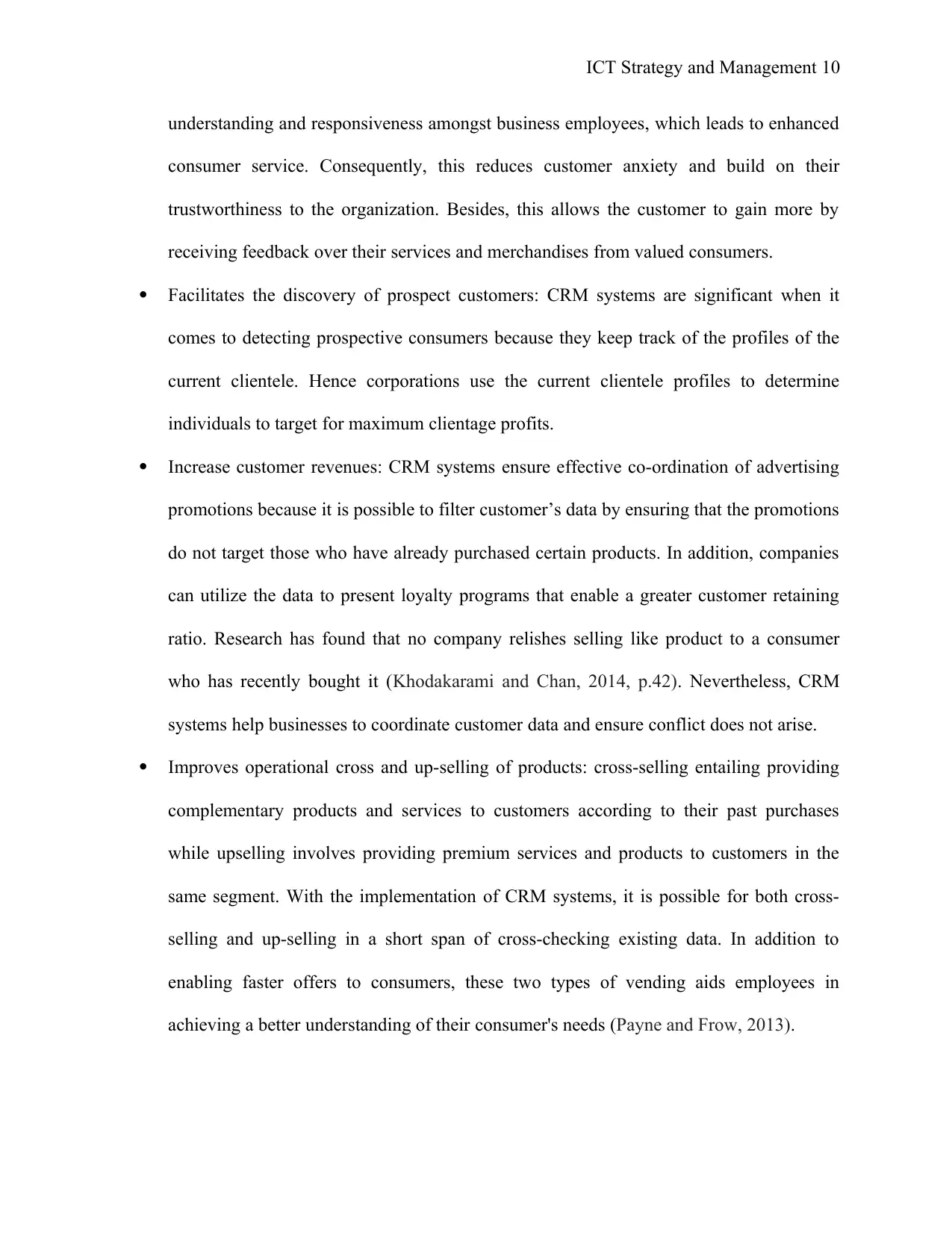
ICT Strategy and Management 10
understanding and responsiveness amongst business employees, which leads to enhanced
consumer service. Consequently, this reduces customer anxiety and build on their
trustworthiness to the organization. Besides, this allows the customer to gain more by
receiving feedback over their services and merchandises from valued consumers.
Facilitates the discovery of prospect customers: CRM systems are significant when it
comes to detecting prospective consumers because they keep track of the profiles of the
current clientele. Hence corporations use the current clientele profiles to determine
individuals to target for maximum clientage profits.
Increase customer revenues: CRM systems ensure effective co-ordination of advertising
promotions because it is possible to filter customer’s data by ensuring that the promotions
do not target those who have already purchased certain products. In addition, companies
can utilize the data to present loyalty programs that enable a greater customer retaining
ratio. Research has found that no company relishes selling like product to a consumer
who has recently bought it (Khodakarami and Chan, 2014, p.42). Nevertheless, CRM
systems help businesses to coordinate customer data and ensure conflict does not arise.
Improves operational cross and up-selling of products: cross-selling entailing providing
complementary products and services to customers according to their past purchases
while upselling involves providing premium services and products to customers in the
same segment. With the implementation of CRM systems, it is possible for both cross-
selling and up-selling in a short span of cross-checking existing data. In addition to
enabling faster offers to consumers, these two types of vending aids employees in
achieving a better understanding of their consumer's needs (Payne and Frow, 2013).
understanding and responsiveness amongst business employees, which leads to enhanced
consumer service. Consequently, this reduces customer anxiety and build on their
trustworthiness to the organization. Besides, this allows the customer to gain more by
receiving feedback over their services and merchandises from valued consumers.
Facilitates the discovery of prospect customers: CRM systems are significant when it
comes to detecting prospective consumers because they keep track of the profiles of the
current clientele. Hence corporations use the current clientele profiles to determine
individuals to target for maximum clientage profits.
Increase customer revenues: CRM systems ensure effective co-ordination of advertising
promotions because it is possible to filter customer’s data by ensuring that the promotions
do not target those who have already purchased certain products. In addition, companies
can utilize the data to present loyalty programs that enable a greater customer retaining
ratio. Research has found that no company relishes selling like product to a consumer
who has recently bought it (Khodakarami and Chan, 2014, p.42). Nevertheless, CRM
systems help businesses to coordinate customer data and ensure conflict does not arise.
Improves operational cross and up-selling of products: cross-selling entailing providing
complementary products and services to customers according to their past purchases
while upselling involves providing premium services and products to customers in the
same segment. With the implementation of CRM systems, it is possible for both cross-
selling and up-selling in a short span of cross-checking existing data. In addition to
enabling faster offers to consumers, these two types of vending aids employees in
achieving a better understanding of their consumer's needs (Payne and Frow, 2013).
Paraphrase This Document
Need a fresh take? Get an instant paraphrase of this document with our AI Paraphraser
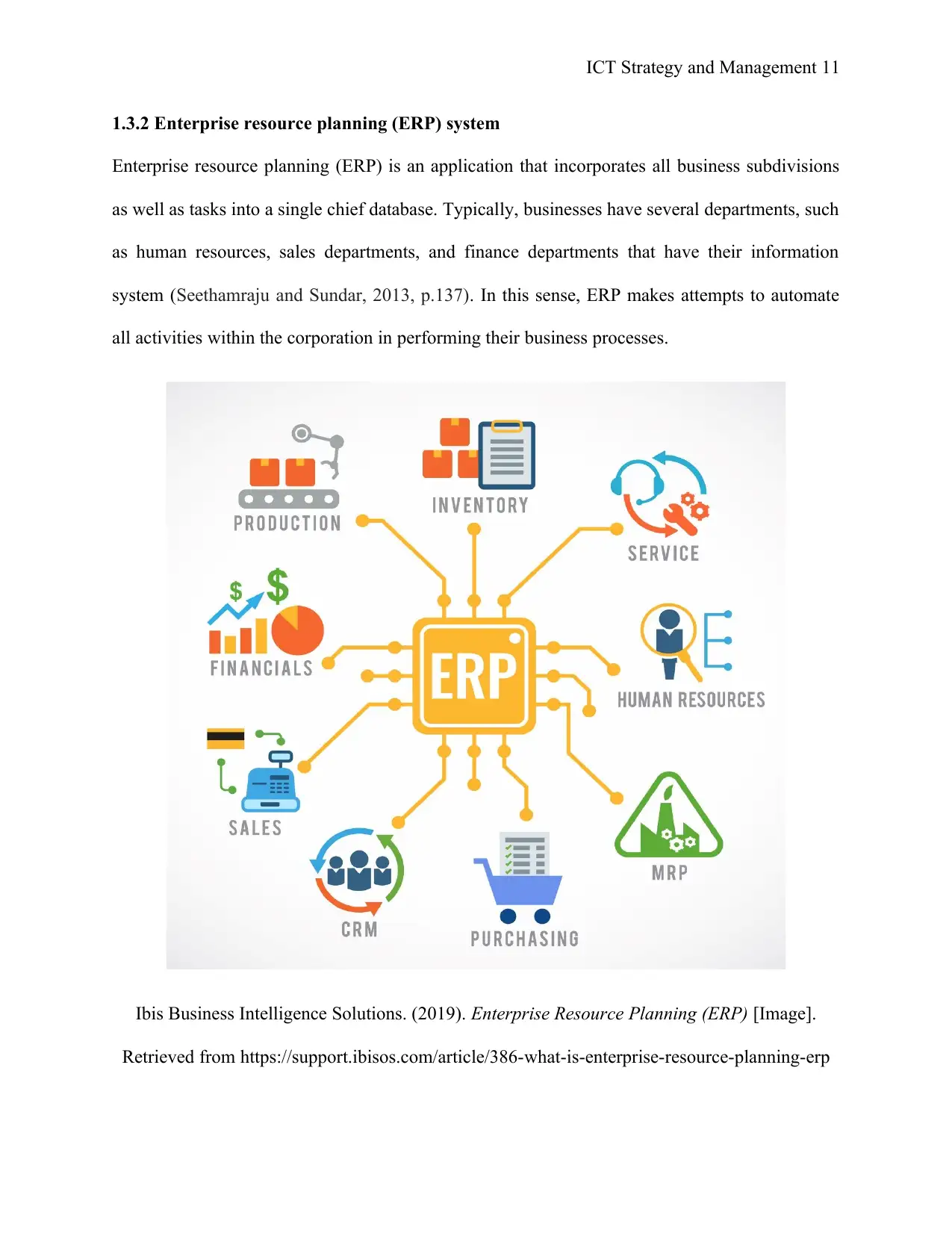
ICT Strategy and Management 11
1.3.2 Enterprise resource planning (ERP) system
Enterprise resource planning (ERP) is an application that incorporates all business subdivisions
as well as tasks into a single chief database. Typically, businesses have several departments, such
as human resources, sales departments, and finance departments that have their information
system (Seethamraju and Sundar, 2013, p.137). In this sense, ERP makes attempts to automate
all activities within the corporation in performing their business processes.
Ibis Business Intelligence Solutions. (2019). Enterprise Resource Planning (ERP) [Image].
Retrieved from https://support.ibisos.com/article/386-what-is-enterprise-resource-planning-erp
1.3.2 Enterprise resource planning (ERP) system
Enterprise resource planning (ERP) is an application that incorporates all business subdivisions
as well as tasks into a single chief database. Typically, businesses have several departments, such
as human resources, sales departments, and finance departments that have their information
system (Seethamraju and Sundar, 2013, p.137). In this sense, ERP makes attempts to automate
all activities within the corporation in performing their business processes.
Ibis Business Intelligence Solutions. (2019). Enterprise Resource Planning (ERP) [Image].
Retrieved from https://support.ibisos.com/article/386-what-is-enterprise-resource-planning-erp
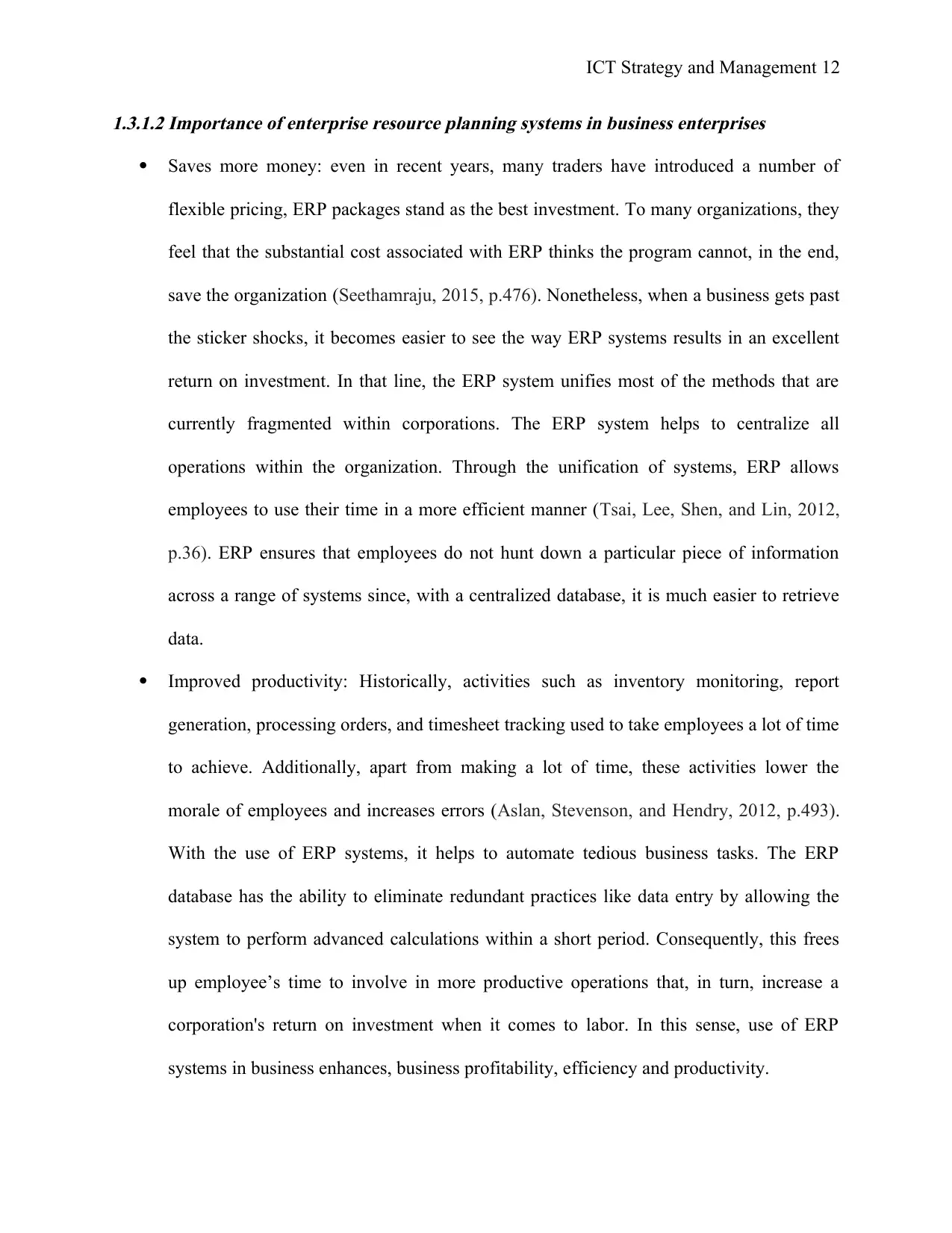
ICT Strategy and Management 12
1.3.1.2 Importance of enterprise resource planning systems in business enterprises
Saves more money: even in recent years, many traders have introduced a number of
flexible pricing, ERP packages stand as the best investment. To many organizations, they
feel that the substantial cost associated with ERP thinks the program cannot, in the end,
save the organization (Seethamraju, 2015, p.476). Nonetheless, when a business gets past
the sticker shocks, it becomes easier to see the way ERP systems results in an excellent
return on investment. In that line, the ERP system unifies most of the methods that are
currently fragmented within corporations. The ERP system helps to centralize all
operations within the organization. Through the unification of systems, ERP allows
employees to use their time in a more efficient manner (Tsai, Lee, Shen, and Lin, 2012,
p.36). ERP ensures that employees do not hunt down a particular piece of information
across a range of systems since, with a centralized database, it is much easier to retrieve
data.
Improved productivity: Historically, activities such as inventory monitoring, report
generation, processing orders, and timesheet tracking used to take employees a lot of time
to achieve. Additionally, apart from making a lot of time, these activities lower the
morale of employees and increases errors (Aslan, Stevenson, and Hendry, 2012, p.493).
With the use of ERP systems, it helps to automate tedious business tasks. The ERP
database has the ability to eliminate redundant practices like data entry by allowing the
system to perform advanced calculations within a short period. Consequently, this frees
up employee’s time to involve in more productive operations that, in turn, increase a
corporation's return on investment when it comes to labor. In this sense, use of ERP
systems in business enhances, business profitability, efficiency and productivity.
1.3.1.2 Importance of enterprise resource planning systems in business enterprises
Saves more money: even in recent years, many traders have introduced a number of
flexible pricing, ERP packages stand as the best investment. To many organizations, they
feel that the substantial cost associated with ERP thinks the program cannot, in the end,
save the organization (Seethamraju, 2015, p.476). Nonetheless, when a business gets past
the sticker shocks, it becomes easier to see the way ERP systems results in an excellent
return on investment. In that line, the ERP system unifies most of the methods that are
currently fragmented within corporations. The ERP system helps to centralize all
operations within the organization. Through the unification of systems, ERP allows
employees to use their time in a more efficient manner (Tsai, Lee, Shen, and Lin, 2012,
p.36). ERP ensures that employees do not hunt down a particular piece of information
across a range of systems since, with a centralized database, it is much easier to retrieve
data.
Improved productivity: Historically, activities such as inventory monitoring, report
generation, processing orders, and timesheet tracking used to take employees a lot of time
to achieve. Additionally, apart from making a lot of time, these activities lower the
morale of employees and increases errors (Aslan, Stevenson, and Hendry, 2012, p.493).
With the use of ERP systems, it helps to automate tedious business tasks. The ERP
database has the ability to eliminate redundant practices like data entry by allowing the
system to perform advanced calculations within a short period. Consequently, this frees
up employee’s time to involve in more productive operations that, in turn, increase a
corporation's return on investment when it comes to labor. In this sense, use of ERP
systems in business enhances, business profitability, efficiency and productivity.
⊘ This is a preview!⊘
Do you want full access?
Subscribe today to unlock all pages.

Trusted by 1+ million students worldwide
1 out of 22
Related Documents
Your All-in-One AI-Powered Toolkit for Academic Success.
+13062052269
info@desklib.com
Available 24*7 on WhatsApp / Email
![[object Object]](/_next/static/media/star-bottom.7253800d.svg)
Unlock your academic potential
Copyright © 2020–2025 A2Z Services. All Rights Reserved. Developed and managed by ZUCOL.





